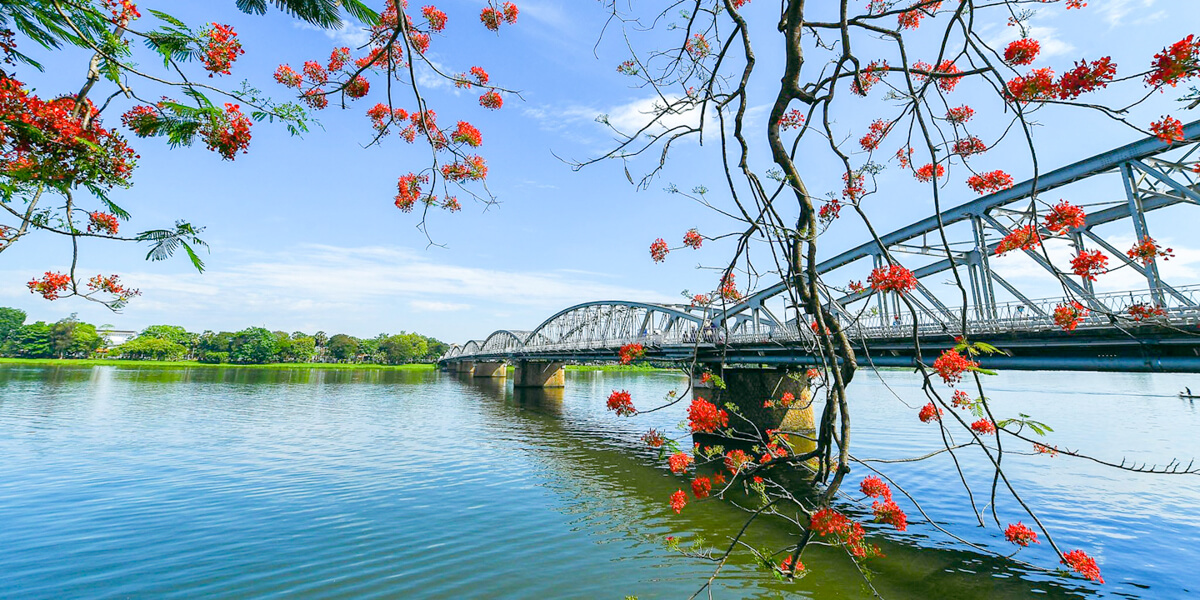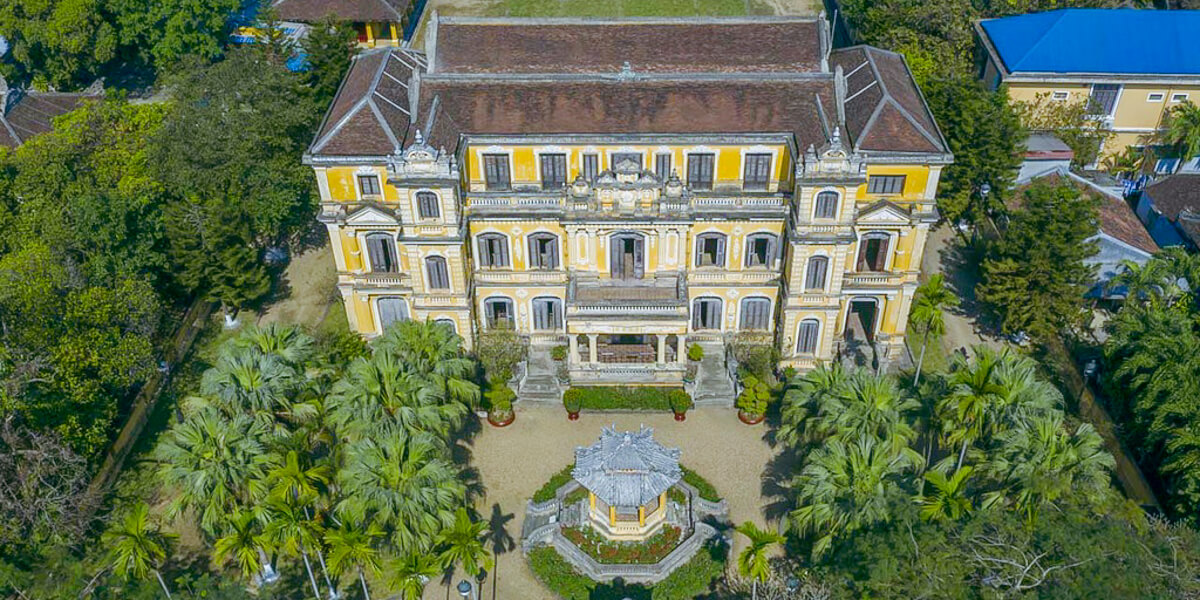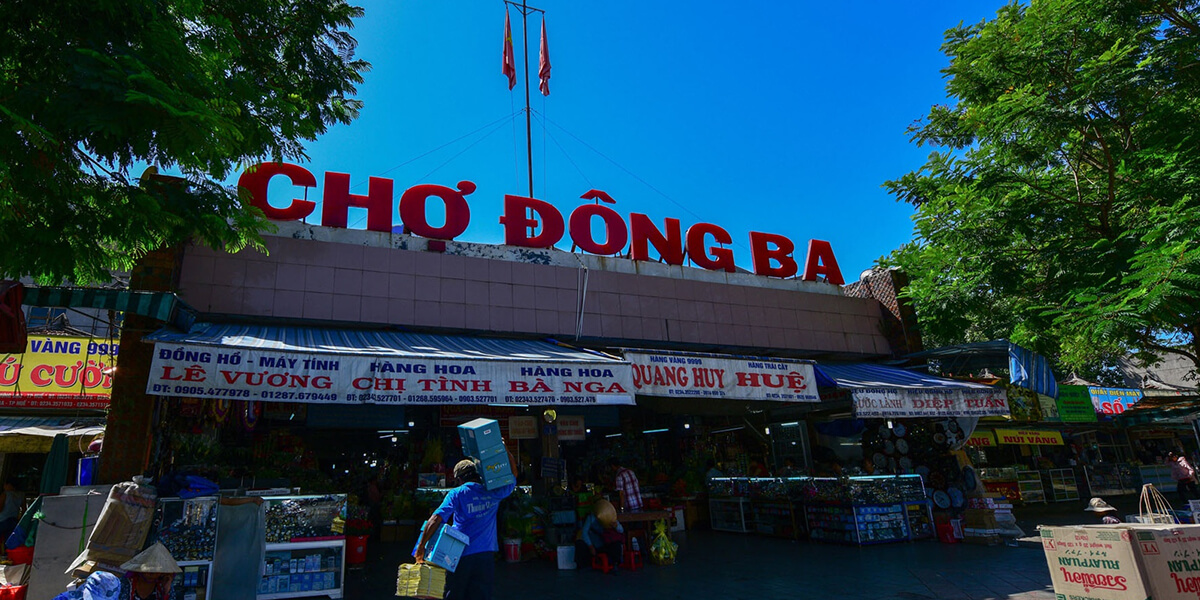Khai Dinh Tomb Hue is located on the hillside of Chau Chu mountain, Thuy Bang Ward, Huong Thuy Town - 10km from the city center. This tomb is the last but most prominent construction in the Nguyen dynasty. Despite its so-called dark and gloomy appearance, the interior is surprisingly delicate and luxurious.
I - Khai Dinh Tomb architecture
The area of this tomb is 5,674m2. It was first built in 1920 and took 11 years to complete under the guidance of Commander Le Van Ba. Unlike other royal tombs in Hue, Khai Dinh’s was constructed with modern materials such as Ardoise tile, concrete and wrought iron imported from France.
The royal tomb of Khai Dinh King was decorated by the carved was made from glass and porcelain originated in China, Japan and other countries. With such an exclusive material utilization, this tomb is an intriguing and unique attraction for tourists and archeologists who pursue the integration of various delicate architectural features from different countries and Vietnamese spiritual values between the past and present. That’s why the tomb of Emperor Khai Dinh is the most effort-consuming and the most expensive tomb of the Nguyen Dynasty.

The tomb from above - Source: VnExpress
Built in the shape of a horizontal rectangle with 5 floors in total, the tomb’s inner sanctum is 127 steps up. Most of the tomb’s details portray the architectural affection of different countries like France, India and diverse religions such as Buddhism, Romanesque and Gothic.
The first floor: The entrance
The gate leading into Khai Dinh Royal Tomb resembles the three-arched-entrances with one main gate and two subordinate ones. The gate is ornamented with four dragon statues which are meticulously carved. Through the gate, tourists can approach Ta Tong Tu and Huu Tong Tu, the two works not only reflect the feudal architecture of Vietnam but also worshipped the mandarins who devoted all of their lifetimes to Vietnam. In the meantime, this place is used for exhibiting the souvenirs and briefing the whole tomb’s architecture.

The honor courtyard in Khai Dinh Tomb Vietnam - Source: Internet
The second floor: The honor courtyard
The courtyard is filled with statues of mandarins, soldiers, elephants, horses and all are meticulously designed, sculpted with rare materials and grafted by ceramic and glass from China and Japan...The whole scene of the court exudes majesty and each statue reveals its own charisma through the gray layout. This work succeeded in illustrating the feudal culture of Vietnam for a while.
The third and fourth floor: Small yards
These two floors contain the small yards leading into Thien Dinh Palace, the place that holds most of the cultural values in the tomb of Khai Dinh. A lot of dragon-like sculptures are demonstrated along the stairs.

Thien Dinh Palace - Source: Tran Trung Hieu
The fifth floor: Thien Dinh Palace
Thien Dinh Palace would prove itself as a pinnacle of visual art thanks to its unique design in this tomb complex. It can not fail to mention the painting ‘Nine dragons hidden in clouds’ manually made from rare stones and porcelain by the best artisans at that time. In the middle of the building stands the copper statue of Khai Dinh King sculpted in the right 1:1 ratio. The statue was cast in France by two French artisans and gilded by Hue artisans and the remains of King Khai Dinh placed under this altar. The whole Thien Dinh Palace in Khai Dinh Tomb Vietnam is divided into three parts:
- Part 1: Khai Thanh temple, where the altar and statue of Khai Dinh emperor is placed.
- Part 2: Buu An, place of two copper cast statues and the royal tomb.
- Part 3: Kham Tho, place to worship the predecessors of the Nguyen’s dynasty.
The delicate and elaborate carvings in the work recalls gratitude, a traditional trait of every Vietnamese. This tomb also reflects the sumptuous preference of Vietnamese kings during their reigns.
II - Entrance fee and opening time
1 - Khai Dinh Tomb entrance fee
- Adults: 150,000 VND/adult ($6.5)
- Children: 30,000 VND/child ($1.3)
2 - Opening hours
From 7am to 6pm
3 - Nearby attractions
Take your time to visit these surrounding places of interest listed below:
- Phat Dung Pagoda, Thuy Bang Ward, Huong Thuy District, Thua Thien Hue Province (2km)
- Pho Minh Pagoda, Kim Son Ward, Huong Thuy District, Thua Thien Hue Province (2km)
- Thien An Monastery, Thuy Bang Ward, Huong Thuy District, Thua Thien Hue Province (3.6km)
- Hiep Hoa Tomb, An Tay, Hue City, Thua Thien Hue province (3.5km)
- Tu Duc Tomb, Thuong Ba Village, Hue City (3.5km)
Khai Dinh Tomb in Hue is an intersection of Eastern and Western design while the value of feudal architectural highlights of Vietnam remains unchanged. This place is worth your while on your Hue day tour if you don’t want to miss a rather small place, yet so magnificent with a new horizon of historical, architectural value and visual art.







 — Quan Nguyen
— Quan Nguyen




































